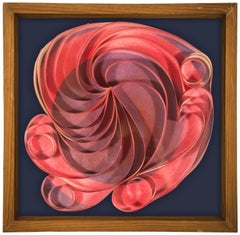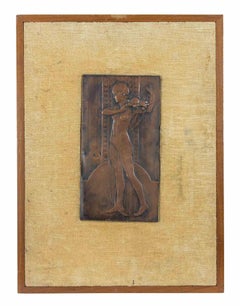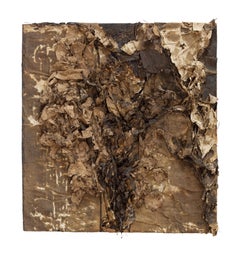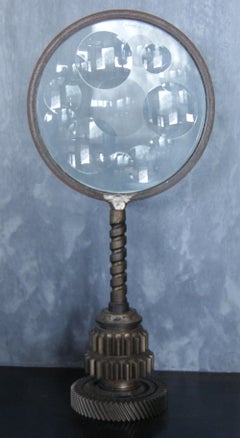Feliciano Béjar Art
to
1
Overall Width
to
Overall Height
to
1
1
1
1
1
6
10,138
2,779
1,375
1,368
1
Artist: Feliciano Béjar
Feliciano Bejar REHILETE #2 Mixed Media Avant Garde Artwork
By Feliciano Béjar
Located in Surfside, FL
Genre: Latin American
Subject: Abstract
Medium: Mixed Media, Collage
Country: Mexico
Dimensions w/Frame: 16.75 x 16.5
Feliciano Béjar Ruíz (1920 – February 1, 2007) was a Mexican ar...
Category
1980s Modern Feliciano Béjar Art
Materials
Mixed Media
Related Items
Ancient Woman - Copper Plate Engraved - Early 20th Century
Located in Roma, IT
Ancient woman is a modern artwork realized by Artist of the early 20th Century.
Copper plate engraved.
Includes frame: 50 x 37 cm
Engraved signature on lower margin.
Category
Early 20th Century Modern Feliciano Béjar Art
Materials
Copper
$1,055
H 10.24 in W 5.52 in D 0.04 in
"Untitled" Gene Hedge, Mid-Century, Collage, Construction Materials, Urban
Located in New York, NY
Gene Hedge
Untitled, circa 1956
Mixed media
14 3/4 x 14 inches
Provenance
Estate of the artist
Gene Hedge was born (1928) and raised in rural Indiana. After military service, he b...
Category
1950s American Modern Feliciano Béjar Art
Materials
Paper, Mixed Media
$4,000
H 19.125 in W 18.125 in
Composition - Mixed Media on Cardboard by Mario Martini - 1975
Located in Roma, IT
Composition is an original artwork realized by the Italian contemporary artist Mario Martini in 1975.
Mixed media colored painting on cardboard
Hand-signed and dated on the lower r...
Category
1970s Modern Feliciano Béjar Art
Materials
Mixed Media
$479
H 27.56 in W 19.69 in D 0.04 in
Composition - Original Mixed Media signed "Rodge" - 1960s
Located in Roma, IT
Composition is an original painting in mixed media on paper signed "Rodge", realized in 1960s.
Hand-signed on the lower right.
Good conditions except for folding and some stains.
...
Category
1960s Modern Feliciano Béjar Art
Materials
Mixed Media
Monochromatic Spiral Reflecting Aluminium Square Artwork
Located in Pasadena, CA
This abstract geometric relief in brushed aluminum embodies the spirit of late modernist design, balancing precision and movement through its rhythmic interplay of curved planes. The...
Category
Late 20th Century Modern Feliciano Béjar Art
Materials
Mixed Media
"Untitled"
By Jean Hélion
Located in Southampton, NY
Important work on paper by French artist Jean Halion. Ink, watercolor and colored pencil study done in 1952. Signed top right in ink and dated in pencil 15-9-52.
Jean Hélion was ...
Category
1950s Modern Feliciano Béjar Art
Materials
Mixed Media, Paper
Nude - Mixed Media Drawing on Paper - 1970s
By Leo Guida
Located in Roma, IT
Nude is an original mixed media drawing on ivory-colored paper realized by Leo Guida in 1970s.
The state of preservation of the artwork is good. Not signed.
INV.15A, on the lower r...
Category
1970s Modern Feliciano Béjar Art
Materials
Mixed Media
"Untitled - Face" Lonnie Holley, Mixed Media, Found and Assembled Objects
By Lonnie Holley
Located in New York, NY
Lonnie Holley
Untitled - Face , circa 1989
Mixed media sculpture, found and assembled objects
25 x 16 1/2 x 4 1/2 inches
Since 1979, Holley has dedicated his life to the realm of improvisational creativity. His artistic expressions and musical works, emerging from adversity and challenges, but even more so from a relentless curiosity and innate need, have taken form in various mediums such as drawing, painting, sculpture, photography, performance, music, and filmmaking. Holley’s sculptures are crafted from found objects, reflecting the ancient traditions of African American sculpture...
Category
1980s American Modern Feliciano Béjar Art
Materials
Wood, Paint, Found Objects, Mixed Media
$10,500
H 25 in W 16.5 in D 4.5 in
Roman Boy - Copper Plate Engraved - Early 20th Century
Located in Roma, IT
Roman boy is a modern artwork realized by Artist of the early 20th century.
Copper plate engraved.
Includes frame: 50 x 37 cm
Engraved signature on lower ...
Category
Early 20th Century Modern Feliciano Béjar Art
Materials
Copper
$1,031
H 10.24 in W 5.52 in D 0.04 in
Wrapped Statues/West Germany
By Christo and Jeanne-Claude
Located in Missouri, MO
Wrapped Statues/West Germany
Christo (Bulgarian, 1935-2020)
Mixed Media
Hand-signed lower right
Numbered PP 1/10 lower left
35 x 27 inches
39.25 x 31.2...
Category
1980s Modern Feliciano Béjar Art
Materials
Paper, Mixed Media, Laid Paper, Lithograph
La Coupe - Original Mixed Media - Late 19th Century
Located in Roma, IT
La Coupe is an original modern artwork realized in Italy in the first years of the late 19th Century.
Mixed media on watermarked paper.
China ink and watercolor drawing.
Very good...
Category
Late 19th Century Modern Feliciano Béjar Art
Materials
Paper, Mixed Media, Ink, Watercolor
$359
H 8.27 in W 11.03 in D 0.04 in
Deposition of Christ - Mixed Media on Paper - 20th Century
Located in Roma, IT
Crucifixion is a modern drawing in mixed media on paper realized by an anonymous artist of the 20 Century.
Very good conditions, with a drawing on the rear.
The artwork represents ...
Category
20th Century Modern Feliciano Béjar Art
Materials
Mixed Media, Charcoal, Oil Pastel, Watercolor
$479
H 9.45 in W 11.82 in D 0.04 in
Previously Available Items
Feliciano Bejar REHILETE #2 Mixed Media Avant Garde Artwork
By Feliciano Béjar
Located in Surfside, FL
Genre: Latin American
Subject: Abstract
Medium: Mixed Media, Collage
Country: Mexico
Dimensions w/Frame: 16.75 x 16.5
Feliciano Béjar Ruíz (1920 – February 1, 2007) was a Mexican artist and artisan, best known for a style of sculpture called “magiscopios” which involved various materials along with crystals and/or lenses to play with light or create distorted visions. He was born in rural central Mexico and was completely self-taught as an artist. He was creative as a young child, drawing and creating his first sculpture like pieces from papier-mâché. His art career began in New York, where he had travelled and lived for a time in Hell’s Kitchen. His drawing the attention of Arthur Ewart and Frances Coleman, with the latter helping him have his first exhibition and whose husband helped sponsor his time in Europe. In his later life, Béjar withdrew from the art world for about sixteen years, disillusioned with it and retreating to his ranch in the State of Mexico. He returned in 1998, with a retrospective of his work in Mexico City and continued to show his work until shortly before his death.
He worked as an assistant to a carpenter, sweeping out the shop in exchange for wood scraps. He used these to create toys and even large imaginary cities.
When he was fifteen, he began to teach himself art using various scrap materials. At this time muralist José Clemente Orozco was in his town to paint scenes of the Mexican Revolution on the town library. Bejar brought him some drawings to show, he did not want to see them. Later in life he stated that he did not think well of the muralists and considered them false and frauds. He said that their work was supposedly for the people but they could not be understood without interpretation and the main ones (Rivera, Siqueiros and Orozco) shut out other artists.
When he got to New York in the 1940s, he was disappointed and thought it ugly. He wanted to return but had no money so he had to work menial jobs and live in Hell’s Kitchen. During this time in New York, he was put in touch with English painter Arthur Ewart who encouraged him to get back to art, particularly painting. He also met socialite Frances Colman, while copying paintings...
Category
1980s Modern Feliciano Béjar Art
Materials
Mixed Media
H 16.75 in W 16.5 in
MAGISCOPE Steel Glass Assemblage Sculpture Mexican Latin American Contemporary
By Feliciano Béjar
Located in New York, NY
Feliciano Bejar (Mexico, 1920- 2007) “Magiscope 20” assemblage sculpture, 8 ¾w x 18 ½h inches, signed and dated 2002 on glass lens, acquired from Galeria des Artistes, Pureto Vallert...
Category
Early 2000s Assemblage Feliciano Béjar Art
Materials
Steel
Feliciano Bejar REHILETE #2 Mixed Media Avant Garde Artwork
By Feliciano Béjar
Located in Surfside, FL
Genre: Latin American
Subject: Abstract
Medium: Mixed Media, Collage
Country: Mexico
Dimensions w/Frame: 16.75 x 16.5
Feliciano Béjar Ruíz (1920 – February 1, 2007) was a Mexican artist and artisan, best known for a style of sculpture called “magiscopios” which involved various materials along with crystals and/or lenses to play with light or create distorted visions. He was born in rural central Mexico and was completely self-taught as an artist. He was creative as a young child, drawing and creating his first sculpture like pieces from papier-mâché. His art career began in New York, where he had travelled and lived for a time in Hell’s Kitchen. His drawing the attention of Arthur Ewart and Frances Coleman, with the latter helping him have his first exhibition and whose husband helped sponsor his time in Europe. In his later life, Béjar withdrew from the art world for about sixteen years, disillusioned with it and retreating to his ranch in the State of Mexico. He returned in 1998, with a retrospective of his work in Mexico City and continued to show his work until shortly before his death.
He worked as an assistant to a carpenter, sweeping out the shop in exchange for wood scraps. He used these to create toys and even large imaginary cities.
When he was fifteen, he began to teach himself art using various scrap materials. At this time muralist José Clemente Orozco was in his town to paint scenes of the Mexican Revolution on the town library. Bejar brought him some drawings to show, he did not want to see them. Later in life he stated that he did not think well of the muralists and considered them false and frauds. He said that their work was supposedly for the people but they could not be understood without interpretation and the main ones (Rivera, Siqueiros and Orozco) shut out other artists.
When he got to New York in the 1940s, he was disappointed and thought it ugly. He wanted to return but had no money so he had to work menial jobs and live in Hell’s Kitchen. During this time in New York, he was put in touch with English painter Arthur Ewart who encouraged him to get back to art, particularly painting. He also met socialite Frances Colman, while copying paintings at the Metropolitan Museum of Art, who helped him get started selling his work. In 1947, he returned to Mexico. Coleman helped him have an exhibition in New York and in 1949, Béjar traveled to Paris and bicycled through Europe to study the art in the museums there, sponsored by UNESCO and Coleman’s husband. He returned again to Mexico in 1950.
He returned again to Europe in 1956, where he painted and worked as a movie extra and radio announcer.
In 1960, Béjar met Englishman and historian Martin Foley, who had come to Mexico to study. They remained friends for over forty years and lived together at Béjar’s ranch until his death, with Foley writing Béjar’s biography. Foley never entered Béjar’s studio because he was concerned with stepping on something.
However, he considered himself an artisan first, valuing his skills as a carpenter, metalworker and bricklayer, rebuilding the house and gardens himself.
In the early 1990s, he withdrew from his art career, disillusioned by the art work, and in 1993, he was confined to a mental facility by his family involuntarily. Although he left the hospital some time later, a number of his family members still considered him crazy.
Béjar was considered to be an environmentalist. One reason for this was that in his early career, he had a sign in front of his house offering to take used materials for his art, and received much. It made him reflect on how much is wasted. His interest in ecology was also spurred by his time in Mexico City, when he lived for a while near Paseo de la Reforma, seeing how its trees and old mansions were deteriorating.
Béjar died in Mexico City on February 1, 2007, of heart failure while in a hospital for tests. He was 86. He left behind about 100 unfinished pieces because of his system of working. He was buried at his ranch in the State of Mexico. Much of his finished and unfinished work is now in the hands of Martin Foley.
Although Béjar did painting, handcrafts and even trades, he is best known for his sculpture, especially a class of sculpture called “magiscopios.” These were created with metal, glass, crystal, plastic and resins, and feature crystals and lenses that distort the onlookers view. He created the first of these with waste metal and other scraps. After he created his first one, he invited Paco de al Maza, Justino Fernández, Salvador Novo and others for dinner. After seeing the work they thought about names with Jorge Hernández...
Category
1980s Modern Feliciano Béjar Art
Materials
Mixed Media
H 16.75 in W 16.5 in
"Tres Ninas Jugundo"
By Feliciano Béjar
Located in Southampton, NY
Oil on masonite painting by Feliciano Bejar, famous Mexican artist. The painting has a dreamlike quality which typifies his paintings which are relatively scarce. This painting is s...
Category
1950s Modern Feliciano Béjar Art
Materials
Oil
Feliciano Béjar art for sale on 1stDibs.
Find a wide variety of authentic Feliciano Béjar art available for sale on 1stDibs. You can also browse by medium to find art by Feliciano Béjar in mixed media and more. Much of the original work by this artist or collective was created during the 1980s and is mostly associated with the modern style. Not every interior allows for large Feliciano Béjar art, so small editions measuring 17 inches across are available. Customers who are interested in this artist might also find the work of Francisco Toledo, Jack Hooper, and Suzan Etkin. Feliciano Béjar art prices can differ depending upon medium, time period and other attributes. On 1stDibs, the price for these items starts at $2,900 and tops out at $2,900, while the average work can sell for $2,900.




